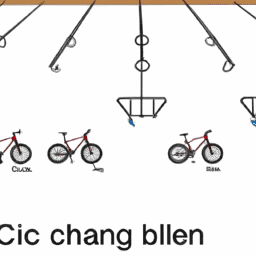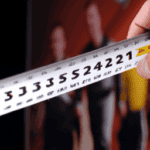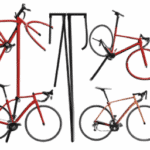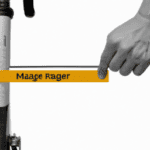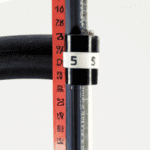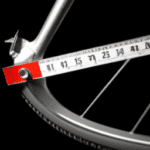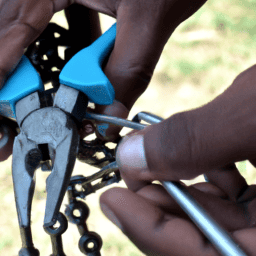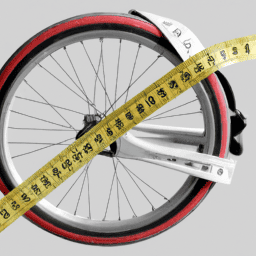For cyclists, selecting the appropriate size for your bicycle frame is crucial to ensure both comfort and efficiency while riding. If the frame is either too big or too small, it can lead to discomfort, negatively influence your balance, and hinder your ability to manage the bicycle effectively.
That’s why it’s important to measure your bicycle frame size accurately. In this article, I will guide you through the steps of measuring your bicycle frame size, so you can find the perfect fit for your riding style and preferences.
Before we dive into the measurement process, you’ll need a few tools to help you get an accurate measurement. You’ll need a tape measure, a level, and a friend to assist you with the measuring process. It’s important to have a level surface to work on, so you can take precise measurements.
Once you’ve gathered your tools, you’ll need to determine your riding style, as this will affect your frame size. Whether you’re a casual rider, a commuter, or a competitive cyclist, there is a frame size that will suit your needs.
So, let’s get started on measuring your bicycle frame size!
Key Takeaways
- The right bicycle frame size is important for both comfort and efficiency while riding.
- Inseam length is a crucial measurement for determining frame size, and proper attire and technique should be used to measure it accurately.
- Different riding styles may require different frame sizes, with mountain bikers often opting for smaller frames and road cyclists preferring larger ones.
- Bike fit involves adjusting various components, including saddle height and handlebar position, and small adjustments should be made and tested before making permanent changes.
Gather Your Tools
Now let’s grab our tools so we can start measuring the frame size of our beloved bike! Choosing appropriate tools is crucial when measuring the frame size.
You’ll need a tape measure, a long level or straight edge, and a friend to assist you. A tape measure that’s at least six feet long is recommended as it’ll be used to measure the distance from the ground to the top of the seat tube or the center of the bottom bracket. The level or straight edge will be used to ensure that the frame is level before taking the measurement.
The importance of accurate measurements can’t be overstated. The frame size of your bike will determine your comfort and safety while riding. An ill-fitting bike can cause discomfort, muscle strain, and even injury. By using the correct tools and taking precise measurements, you can ensure that your bike fits you perfectly and is safe to ride.
Now that we have our tools ready, let’s move on to determining our riding style.
Determine Your Riding Style
Discovering your preferred way of riding will help you find the perfect fit for your new set of wheels. Are you a mountain biker or a road cyclist? Do you prioritize comfort or performance? These are just some of the questions you need to ask yourself in order to determine your riding style. Knowing your riding style is crucial in determining the appropriate frame size for your bike.
To help you determine your riding style, take a look at the table below:
| Riding Style | Terrain | Speed | Comfort |
|---|---|---|---|
| Mountain Biking | Off-road trails, rugged terrain | Moderate | Less emphasis on comfort |
| Road Cycling | Paved roads, flat surfaces | Fast | More emphasis on comfort |
By understanding your preferred riding style, you can then choose a bike frame size that fits your needs. If you’re a mountain biker, you may opt for a smaller frame size to allow for more maneuverability on rugged terrain. On the other hand, if you’re a road cyclist, you may prefer a larger frame size to accommodate a more comfortable riding position. Knowing your riding style is the first step in finding the right bike frame size for you.
Transitioning into the subsequent section, measuring your inseam is the next step in determining the appropriate frame size for your bike.
Measure Your Inseam
Determining your appropriate bike fit starts with understanding your inseam length. To accurately measure your inseam, you’ll need to wear the proper attire, such as form-fitting pants or shorts, and stand with your feet shoulder-width apart.
Place a book or flat object between your legs, with one end pressed against your crotch, and measure the distance from the floor to the top of the book. This measurement will give you your inseam length, which is essential in achieving a comfortable and efficient bike fit.
Common mistakes in measuring inseam length can lead to an improper bike fit, which can result in discomfort, pain, and even injury. Professional fitting services can provide accurate measurements and ensure proper bike fit. However, if you choose to measure your inseam length at home, be sure to follow the proper technique and double-check your measurements for accuracy.
Once you’ve determined your inseam length, you can move on to calculating your frame size for a bike that’s tailored to your body and riding style.
Calculate Your Frame Size
Figuring out the right fit for your bike involves finding the perfect puzzle piece for your body, like a glove. Once you’ve got your inseam measurement, you can calculate your frame size. This is crucial because a frame that’s too small or too large can lead to discomfort and even injuries during long rides.
Frame material is also an important factor to consider when choosing a bike. Different materials, such as aluminum, carbon fiber, or steel, have different properties that affect the bike’s weight, stiffness, and durability.
Additionally, bike fit isn’t just about frame size but also about adjusting the saddle height, handlebar position, and other components to match your body’s proportions and riding style. By taking the time to properly measure and adjust your bike, you can optimize your comfort and performance on the road or trail.
Now let’s talk about how to test ride and adjust your bike to fine-tune its fit.
Test Ride and Adjust
Ready to hit the road? Let’s hop on your bike and make some adjustments to ensure the perfect ride.
Proper fit is critical for comfort and efficiency when cycling. Adjusting the handlebars and seat height can make a significant difference in your ride experience.
To start, adjust the handlebars so that they’re parallel to the ground, and your arms are at a comfortable angle. You don’t want to be reaching too far forward or stretching too far back. Once you’ve found the right position, tighten the bolts on the stem to secure the handlebars in place.
Next, adjust the seat height so that your legs are almost fully extended at the bottom of the pedal stroke. This’ll help you generate more power and prevent injury. Adjust the seat post accordingly and tighten the clamp to secure it in place.
By properly adjusting your handlebars and seat height, you’ll be able to enjoy a comfortable and efficient ride. Remember to make small adjustments and test ride your bike before making any permanent changes.
Happy cycling!
Frequently Asked Questions
How do I know if my bike frame is too big or too small for me?
When sitting on the bike, my feet should touch the ground. Saddle height should be adjusted so my leg is almost fully extended when pedal is at the bottom. Handlebar reach should allow for comfortable grip while maintaining proper posture.
Should I consider the type of bike I want before measuring for frame size?
Before measuring frame size, I consider bike type. For kids’ bikes, I measure inseam and use a chart. For other types, I measure inseam and arm length, then consult a chart or bike shop for more precise measurements.
Can I adjust the frame size of my existing bike if it doesn’t fit me properly?
I once bought a bike with a frame that was too big for me. I adjusted the fit by swapping out the stem and handlebars. A professional fitting service can also help with adjustments to improve comfort and performance.
Are there any other factors besides frame size that affect bike fit?
Cycling posture and handlebar position are critical factors in achieving an optimal bike fit. Correct posture ensures proper alignment of the spine, while handlebar position affects shoulder and arm comfort. These factors must be considered alongside frame size for maximum comfort and performance.
How often should I re-measure my frame size as my body changes over time?
Tracking changes in my body is important for adjusting fit on my bike. I re-measure my frame size every year or when I notice discomfort while riding. It’s like a tune-up for my body and bike, making sure everything runs smoothly.
Conclusion
In conclusion, measuring your bicycle frame size is an essential step in ensuring your riding experience is comfortable and enjoyable. As a seasoned cyclist, I can attest to the importance of this process.
One time, I rode a bike with a frame that was too small for me, and my knees constantly hit the handlebars, causing discomfort and pain. To avoid such situations, it’s crucial to gather the necessary tools, determine your riding style, measure your inseam, and calculate your frame size accurately.
This process will help you select a bicycle that fits you perfectly, ensuring that you can ride for extended periods without any discomfort. It’s like finding the right shoe size; if your shoes are too small, you’ll experience pain and discomfort when walking, and the same applies to riding a bicycle with the wrong frame size.
In conclusion, measuring your bicycle frame size is a fundamental process that every cyclist should undertake. It’s a technical process that requires precision and attention to detail, but it’s worth the effort. So, if you want to enjoy your cycling experience, take the time to measure your frame size accurately, and test ride your bicycle to ensure the fit is perfect. Remember, finding the right size is like finding the perfect pair of shoes – it’ll make all the difference in your comfort and enjoyment.

